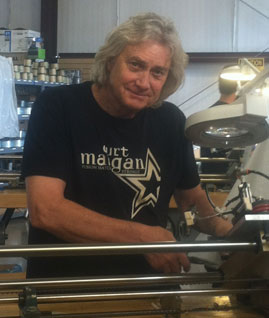INTERVIEW WITH CURT MANGAN
 Q: What led to your decision to become a string manufacturer and when did you begin to get involved in that business?
Q: What led to your decision to become a string manufacturer and when did you begin to get involved in that business?
Curt: I have a long history with strings having played, installed, sold and now building them. In 2004, after 17-years as Director of Sales and Marketing at Ernie Ball, I thought there might be a little room for a small string manufacturer and decided to try it.
Q: Could you give a brief history of strings and the major differences between the early strings and modern strings?
Curt: String making became more automated in the 1950’s due to advances in machinery. Gaining more control of the string making process continues and each improvement increases consistent quality. However, the process still remains labor intensive.
Q: What are the most important factors in making quality strings?
Curt: Developing a balanced recipe that includes, core-to wrap ratios, tension on the core wire while winding the string, selecting and obtaining the best raw materials, pride in craftsmanship, attention to details and testing each batch.
Q: Could you explain the differences between your various guitar strings and the sound and feel of each type?
Curt: It is difficult to describe tone, but I will go with this.
Nickel-Plated Steel commonly called nickelwound has become the most popular wrap alloy for electric guitars and basses. It has nice highs, mids and lows.
Pure nickel still has plenty of twang, but has a slightly warmer sound and many players think they feel smoother than nickel-plated steel.
Stainless steel is somewhat brighter and some players think the feel is a little less smooth than nickel-plated steel. 80/20 bronze (80% copper/20% zinc) for acoustic instruments seems to have a flat response with maybe a slight boost in the mid-range.
Phosphor bronze (92% copper /7% zinc / 1% phosphor) seems to have enhanced highs and lows with a touch less mid-range. Some say it’s like pushing the loudness button on your stereo. Some also say phosphor feels a little smoother than 80/20 bronze.

